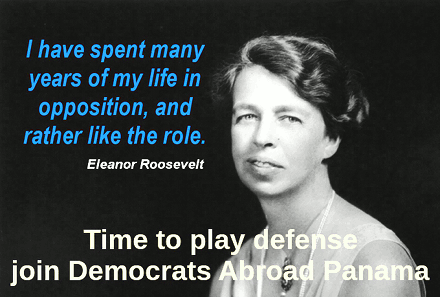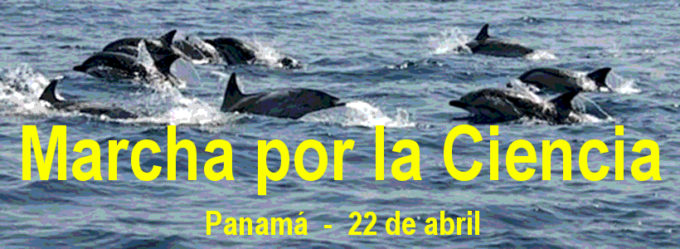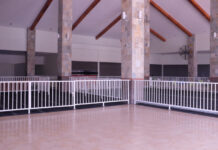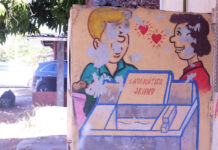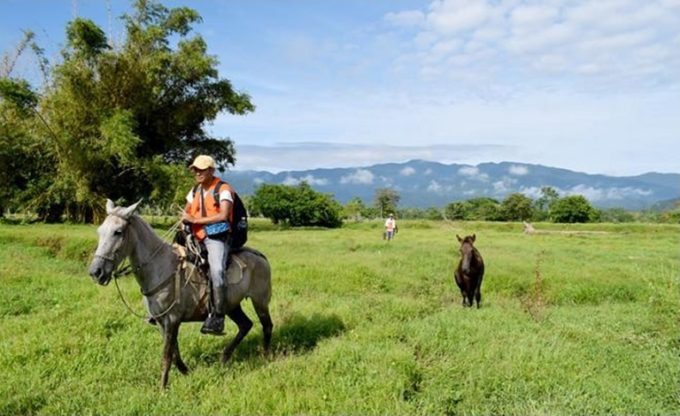
Successful Colombian rainforest project exposes
problems with carbon emissions trading
by Bart Crezee — De Correspondent / Mongabay
Ferney Caicedo, a trained forest ranger, is slipping and sliding over the forest path while he leads a horse and a group of four other people up a hill. Rain from the night before has made the wooded slopes almost impossible to ascend. The humidity is high. Sweat drips constantly from underneath Caicedo’s cap. This is the tropical rainforest in the extreme northwest of Colombia.
This is familiar terrain to Caicedo. On a clear day, he says that you can see the Caribbean Sea from atop the peak he is now climbing. In the other direction lies the border with Panama, somewhere in the impenetrable jungle of the isthmus connecting North and South America. Known as the Darién Gap, it runs between Colombia and Panama and is made up of marshland, mountains, and tropical rainforest. It’s the only still-unfinished part of the famous Pan-American Highway, which will someday connect North and South America. Although there have been plans to complete the road for years, so far the impenetrable jungle, as well as several rebel groups hiding out in it, have made it impossible.
Caicedo and his team of colleagues work to protect the forests for COCOMASUR, short for “Consejo Comunitario Mayor de la Cuenca del Rio Tolo y la Zona Costera Sur de Acandí,”the community council of the Tolo River basin and the coastal zone south of Acandí. The organization represents 2,600 Afro-Colombians, or about half of the total population of the municipality of Acandí. These Colombians are descended from African slaves. In Colombia, Afro-Colombians are seen as a separate ethnic group, along with the many native communities in the country. About 80 percent of the population of the northwestern region of Chocó is Afro-Colombian.
Wearing fluorescent orange safety vests and armed with machetes and GPS equipment, they trek through the forest every day to stop deforestation.
Some of the trees Caicedo works to protect can reach over 100 feet high.
“The wood from one of these trees will fetch a lot of money on the market,”he said. But the community is too remote for logging to be profitable for them. Acandí, the closest village, is an hour away from the community by motorcycle taxi. From there, it’s another two hours by boat over the Caribbean Sea to Turbo, the nearest major city. The dense forests make overland travel impossible.
Consequently, since before anyone can remember, the rainforest has been burned down to create new land for agriculture, on average about 200 hectares (nearly 500 acres) per year. In particular, large landowners from outside the community have tried to get their hands on more and more valuable land this way.
Meanwhile, COCOMASUR has found a way for the community to earn money from their own forests. By stopping illegal logging, the community has been able to prevent a lot of CO2 emissions. And that’s worth money these days, in the form of carbon credits. Under an international trading mechanism called REDD+, (reducing emissions from deforestation and forest degradation), these credits can be bought by banks, energy companies, and other corporations such as airlines wanting to reduce their ecological footprint.
The Chocó-Darién Conservation Corridor, as the community’s REDD+ project is called, is the first REDD+ project to be certified in Colombia. In 2012 it was the first REDD+ project operating on community land in the world. The Chocó-Darién project was awarded a Gold Level certification from the Climate, Community & Biodiversity Alliance for its outstanding contribution to biodiversity. Over 500 different bird species have been recorded within the project boundaries. The area is also home to 42 endangered animal species (including a Central American tapir and the Colombian spider monkey) and 15 endangered plant species.
The fact that this is collectively-owned land is important, said Brodie Ferguson in a Skype interview. An American anthropologist who helped the village set up the REDD+ project, Ferguson explains that under the Colombian constitution, Afro-Colombian communities have the right to collective ownership of the land they have traditionally lived on.
“This made it possible for COCOMASUR to decide together about the use of their land,”Ferguson said. “Their culture and identity as a community are directly connected with the land on which they live.”
This sentiment is underlined by the text on the white T-shirts that Caicedo and his team are wearing under their vests: “Por el rescata de nuestra identidad cultural, y el manejo ordenado del territorio“(For the rescue of our cultural identity, and the orderly management of the land).
Taking matters into their own hands
From the late 1980s until the beginning of this century, this area was plagued by heavy violence. The Afro-Colombians were driven apart and thrown off their land by extreme-right-wing paramilitary groups paid by large landowners from Medellín, Bogotá or other cities. For next to nothing, these landowners could buy up enormous parcels of land and destroy the rainforest to create pastureland for grazing their livestock. You still have to pass their vast livestock ranches on the way to this far corner of Colombia.
You still have to pass these landowners’ vast livestock ranches on the way to this far corner of Colombia.
Everildys Córdoba was one of those who fled the violence with her children. Since returning to the village in 2010, she has devoted herself to healing the divided community of COCOMASUR. With her jet-black hair and sparkling dark eyes, the charismatic Córdoba is a natural leader who everyone calls out hello to when she walks down the street.
Córdoba’s family has always been the heart of the community. Her uncle was the village leader in 2009, when he first put forth the idea of REDD+. Following in his footsteps, Córdoba has taken on the project’s day-to-day operations.
Starting up something new in this part of Colombia is a nearly impossible task. There are only three ways for the local population to earn money: logging, working as a day laborer on one of the big cattle ranches, or emigrating to the city.
“None of the three are long-term options,”Córdoba said. “Saving the forest through the REDD+ program was the best way to invest in the community.”
A successful project
But convincing everyone of the idea wasn’t easy. The community of 2,600 is spread out over nine hamlets and was still extremely divided in the aftermath of the violence. It took Córdoba over two years to get all the residents to back the plan.
“But the people who had objected the most then are the most enthusiastic now,”she said with a grin.
After a lengthy information campaign, the whole community decided to approve the project. From that day on, cutting down forests for agriculture was prohibited. Timber for constructing houses may only be cut in specially designated zones now. In the meantime, nearly 13,500 hectares (some 33,000 acres) of tropical rainforest have been protected.
The logistical challenges of the project were legion. To begin with, the forest boundaries and its carbon content had to be determined. Ranger team leader Caicedo spent six months in the forest measuring the thickness and height of the trees. Then it was another six months, using satellite data, before this information could be translated into actual carbon credits. But now that it’s done, everyone knows precisely how much carbon is stored in the forest.
In 2012 these credits were among the first 100,000 carbon credits to be put on the market.
Over the next 30 years, this land is expected to generate a reduction of 2.8 million metric tons of CO2 — that’s like taking 25,000 cars off the road every year. The Chocó-Darién Conservation Corridor has an initial duration of 30 years, during which new CO2 credits are issued every other year by external certification bodies.
The project has Verified Carbon Standard (VCS) and the Climate, Community & Biodiversity Standard (CCB) certification. These are the two most widely used standards for REDD+ projects worldwide.
On patrol against illegal logging
Out on patrol with Caicedo, we come to a flat clearing. Two years ago, a large landowner from outside the community clear-cut the land even though it was illegal, and soon will be grazing his cows here. Tree trunks still lay strewn about, rotting away in the grass.
“These forests have to be protected,”Caicedo said. “Not only for the carbon credits, but also to retain the water and prevent erosion. In the long term, that benefits the cattle ranchers too.”
In addition, the project helps maintain the region’s astonishing biodiversity. Recently, some villagers even spotted a rare wild tiger, a sign of a thriving ecosystem.
Caicedo explains that when they run into illegal loggers, they simply start the conversation by “telling them that logging is prohibited in this area.”That can be dangerous, since some of the loggers are armed. Until now, no one dared to try to stop them.
But Caicedo knows he has the support of the entire community.
“Our goal is mainly prevention,”he said. “Just by being in the forest every day.”
The challenge of marketing
However, selling the CO2 certificates makes protecting the forest look easy by comparison. COCOMASUR sells the CO2 saved by the project on the international carbon-credit market. But that’s more complicated than it sounds.
The problems started in 2012, according to Ferguson.
“We went to the market to sell the first CO2 credits,”he said. “But it turned out that the demand that we anticipated in 2009 didn’t exist anymore.”
Worldwide, there are eleven obligatory (“compliance”) compensation markets, of which the European ETS (emissions trading system) is the best known. But these markets were only intended for specific industrial sectors. International trade in REDD+ certificates is often not even an element of these trading systems, and thus takes place on a voluntary basis.
Ferguson therefore had to very actively approach buyers himself, and ran into roadblocks.
“Nobody is obliged to buy CO2 compensation,”he said. “That means that projects like ours are not financially sustainable in the long term.”
In total, 27.3 million metric tons of CO2 were traded on the voluntary offset market in 2015. At the same time, 39.7 million metric tons went unsold. In other words, for every CO2 credit sold, 1.6 credits stayed on the shelf.
In the meantime, REDD+ projects are putting new CO2 credits on to the market every year. An additional 40 million metric tons is expected for 2016 alone. This brings the total surplus to nearly 80 million metric tons of CO2, according to a report by environmental NGO Forest Trends. This surplus has substantially lowered the price of CO2 credits from REDD+ projects for the last few years. In 2012 the average price was still almost $8 per metric ton. In 2013 it dropped to about $5, in 2014 to $4 and last year the price was fluctuating around just over $3 a metric ton.
“The market has completely bottomed out,”Ferguson said.
In 2016, the price for a metric ton of CO2 rose slightly, to $4.25 a ton in September, notes the 2016 REDD Price Report by Thomson Reuters, following the Paris climate accord and agreements about emissions reductions in the aviation sector. Ferguson hopes that the aviation sector will use REDD+ to compensate its emissions, which would at least partly offset the low demand.
Investing more doesn’t work anymore
Since 2013, it’s been very hard for COCOMASUR to make ends meet. The income they make from selling CO2 credits goes to two things: paying off the debts incurred by setting up the project, and the ongoing operational expenses, such as bookkeeping, forest patrols and new certification rounds.
All other income from sales of offsets must go to a “development fund,”for solar panels, a health clinic or other priorities set by COCOMASUR. The problem is that income from sales of CO2 credits is not enough to even cover the operational expenses now.
“A minimum price of something like $10 per ton of CO2 would be an enormous help to REDD+ projects worldwide,”Ferguson said.
“When we started this project, the expectation was that the carbon price would be $10-$20 a ton,”he added. “But the prices are much lower now. That’s a fundamental problem. The idea is to use the carbon income to create other forms of employment for the community, the way microfinancing helps small businesses. We can’t make those investments now.”
Ferguson says that solution should include a “minimum price”of about $10 per ton of CO2 to help REDD+ projects globally.
“That would be a real incentive for sectors like aviation to reduce emissions,”he added. “But that means that someone has to pay the difference, so ticket prices will go up.”
Thus, companies will have to be forced into it after all. It’s ultimately another form of taxation, a carbon tax, and Ferguson said that it will “require political will.”
In spite of its financial problems, according to community leader Córdoba, the project is still quite a success — largely because of the sense of community it created.
“The project was jointly implemented. It gave structure to a torn community,”she said.
More than thirty jobs, including Caicedo’s, have been created, and have kept the project going. Investments were also made in an office and computers. “This gives COCOMASUR the ability to organize similar projects for the community in the future. It’s made us much stronger,”said Córdoba.
Córdoba is also proud of the fact that everything was set up without government support. Recently, COCOMASUR began to help set up REDD+ projects in other parts of the country. The government sees the project as a model of what REDD+ can do for the country.
For Ferguson, ultimately the most important aspect of REDD+ is the increased awareness.
“Nobody likes polluting; nobody’s smiling while they write a check to pay for offsets,”he said. Though REDD+ is ultimately a temporary solution, he thinks that providing direct compensation is making organizations and consumers more aware of their impact on the climate. “The indigenous communities in Colombia are reconnecting with the opportunities their land presents for them.”
Caicedo agrees: “Thanks to REDD+, we’ve been able to claim another future for ourselves.”
- The Chocó-Darién Conservation Corridor, as the community’s REDD+ project is called, is the first REDD+ project to be certified in Colombia. In 2012 it was the first REDD+ project operating on community land in the world.
- COCOMASUR, an organization representing 2,600 Afro-Colombians, utilizes a team of forest rangers to monitor the tropical rainforest.
- Despite their success, now the community is struggling to get compensated due to a carbon trading market that has “bottomed out.”
This article was produced part of a series on CO2 compensation, made possible in part by support from the Netherlands’ Postcode Loterij Fonds from Free Press Unlimited. Read more (in Dutch) about the Postcode Lottery’s journalism fund. It was translated from the original in Dutch by Anne Hodgkinson.
Bart Crezee is a contributing correspondent on carbon offsets for De Correspondent. This article originally appeared in Dutch on www.decorrespondent.nl. You can find him on Twitter at @bartcrezee.
~ ~ ~
These announcements are interactive. Click on them for more information.



